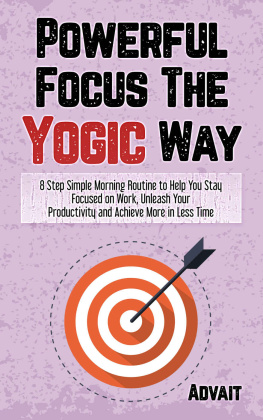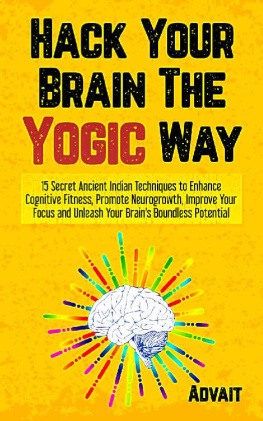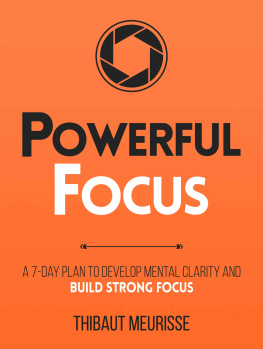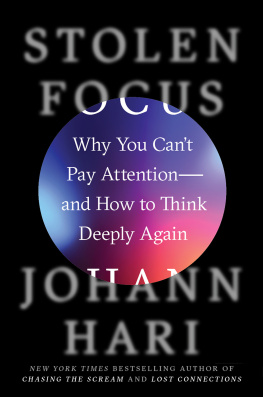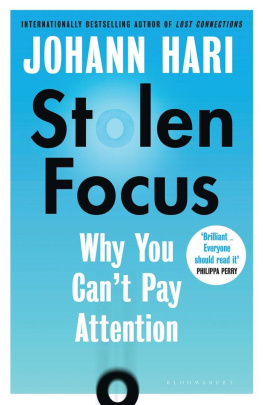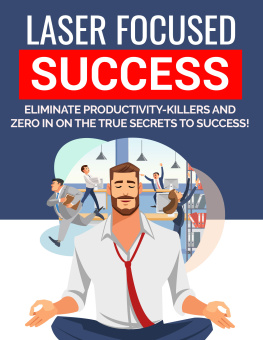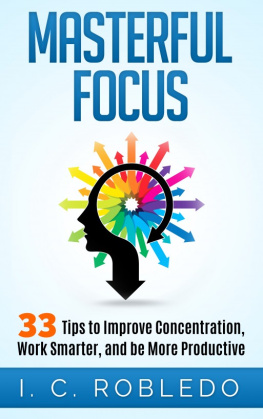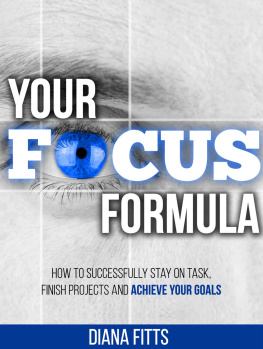If you are my regular reader and are familiar with my previous works, you know that my books are very execution oriented and have zero fluff.
I do not eat up your precious time by going on and on for dozens of pages about the theory and philosophy behind the issue at hand and then leave you high and dry without any actionable instructions.
Rather, my works are chock full of step-by-step techniques, that you can immediately start implementing and practicing within hours of getting my book.
I take pride in this ability of mine to quickly help people in need and want to promise you that this book will be no different.
Finally, this is a book on developing a powerful focus. If that wasn't your desire in buying this eBook, then you can return it within seven days for a full refund from Amazon.
Introduction
For us humans, distraction comes naturally while, focus and attention has to be willfully earned.
Why? You may ask one wordEVOLUTION.
Distraction is an asset, essential for survival.
Think
Our ancestors were searching for tubers or hunting small animals for food in dense forests.
If anyone focused solely on the tuber to dig up, fruit to pluck or the rooster to strike and lost context of where they were standing, from a nearby bush a predator would pounce and make a delicious meal out of them.
So, instead of having a laser sharp focus if, they kept looking around and continuously scanning for a sound of a twig broken under the paw of a predator, or looked out for a sliver of movement behind the bushes; they would be able to save themselves and thus eventually passed on their genes.
Dont yet believe me?
Here is a simple task-
You will need only 30 seconds for it;
Sit still, put down the book, be a bit attentive and just sit there.
After 30 seconds are up, in your mind, simply count the times that your eyes shifted/bounced from one thing to another.
I guarantee that your eyes bounced at least 15 to 17 times in these 30 seconds.
In other words you shifted your focus once every 2 seconds!!!
That is the secret of our survival as a species.
The age of distraction overdose
Now combine our inherent ability to be distracted, with our modern day lifestyle.
The n number of notifications that keep our phones buzzing every other minute, the never before over-abundance of information at our fingertips, one swipe buying opportunities and millions of movies ready to be streamed at your beck and call and how can I forget all those kitten videos; cute, soft, little balls of fur awwww.
.
.
Where was I?
Right,
Focus the most difficult thing to achieve and even more difficult to sustain once you have it.
What happens inside our Brain?
When we do focus on something, let us understand what happens inside our brain.
The part of our brain that deals with focus and makes us pay attention to any particular thing is located in the brain stem i.e. in the cerebellum.
Cerebellum is the part of our brain that has the highest density of neurons.
Whenever we need to focus on something, the cerebellum generates and sends electrical impulses to the pre-frontal cortex (that controls our vision and other sensory inputs) and the motor cortex (that controls our movements), which results into us focusing on the thing at hand.
The impulses generated in the cerebellum are transferred to the cortices in the brain through a bunch or group of neurons called as the basal ganglia.
A smooth and rapid transmission of impulses through the basal ganglia results in a proper, sharp focusing of our attention.
Secretion of two important hormones, viz. Dopamine and Norepinephrine, at the basal ganglia results into a smooth transmission of these electrical impulses.
Imagine the basal ganglia as a road for transportation;
When there is enough dopamine and norepinephrine this road becomes a smooth racing track, if the dopamine generation in your brain is inadequate this road resembles a countryside, ill maintained one, full of potholes.
Developing powerful focus
To develop focus, we need 2 things;
1) Healthy growth and maintenance of neurons in the cerebellum.
2) Adequate production of dopamine and norepinephrine in the basal ganglia.
How to stimulate the growth of neurons in the cerebellum? Will be the next logical question.
It is simple.
The cerebellum is involved when one performs complex movements that are required to be done in a particular sequence and in a rigid, pre-defined way.
A complex dance sequence having multiple, sequential steps, a kung fu kata, a Tai-chi sequence or a Yogic exercise sequence, fires up the cerebellum and puts it in overdrive.
At the same time, if the exercises are done in an abundance of oxygen with regulated breathing and when you purposefully acknowledge the completion of certain micro- tasks and treat them as small wins and achievements; it stimulates the production of dopamine and norepinephrine.
The Yogic routine that I teach you in the next few pages is specially designed to help you in developing powerful focus, after youve been through the routine.
How to use the techniques you will learn in this book?
Our focus, is the most limited and constrained resource that we possess.
Having a laser sharp focus is also very exhausting on our mind and thats why we are able to focus in patches.
You cannot be extremely focused at all times, you have to choose your focus spots and prepare your body and will to extend the duration of those focus patches.
After you practice the yogic routine that I will teach you, you can have a few hours of hyper focus.
Practice this routine in the morning, most preferably half an hour after you have your breakfast.
Then, make sure that you categorize you work and schedule the most important work of that day, in the next 4 to 6 hours of practicing the 8 step routine.
Then, when you start to feel like your focus is wavering after a few hours of meaningful work, take a short break.
Freshen up and then practice the Meditation (step #8) and while meditating first perform the Trimukh Mudra (step #6) for 2-3 minutes and then follow up with the Prana Mudra (step #7) for 3-4 minutes and then end the meditation. This will help you regain your focus for the next sprint.
Pranayama
()
What is Pranayama?
Pranayama is considered of paramount importance in Yoga.
The word Pranayama is made of two basic Sanskrit words-
Pran ( ) = Life or Universal Life Energy.
Ayam ( ) = to Extend and Elongate.
Thus Pranayama means an exercise which is to be performed if you want to extend your life.
Pranayama is the fuel of life
Here is an interesting analogy-
You are familiar with the existence of the seven (7) chakras along the spine,which are considered as the energy points sustaining life and health.
If these Chakras are the rotating wind mills which produce energy to sustain life,then prana is the essential wind energy which makes the hands of a wind mill rotate, to produce that energy.
When we breathe in we take in the essential oxygen along with the all-pervading Prana.[And when we breath out we push out the expended energy and toxins out of our body.]
Ayurveda calls our digestion as 'Jathar Agni' literally meaning 'digestive fire', it compares our digestive process with a 'Yadnya' - A holy Pyre, where things are offered to the gods.

